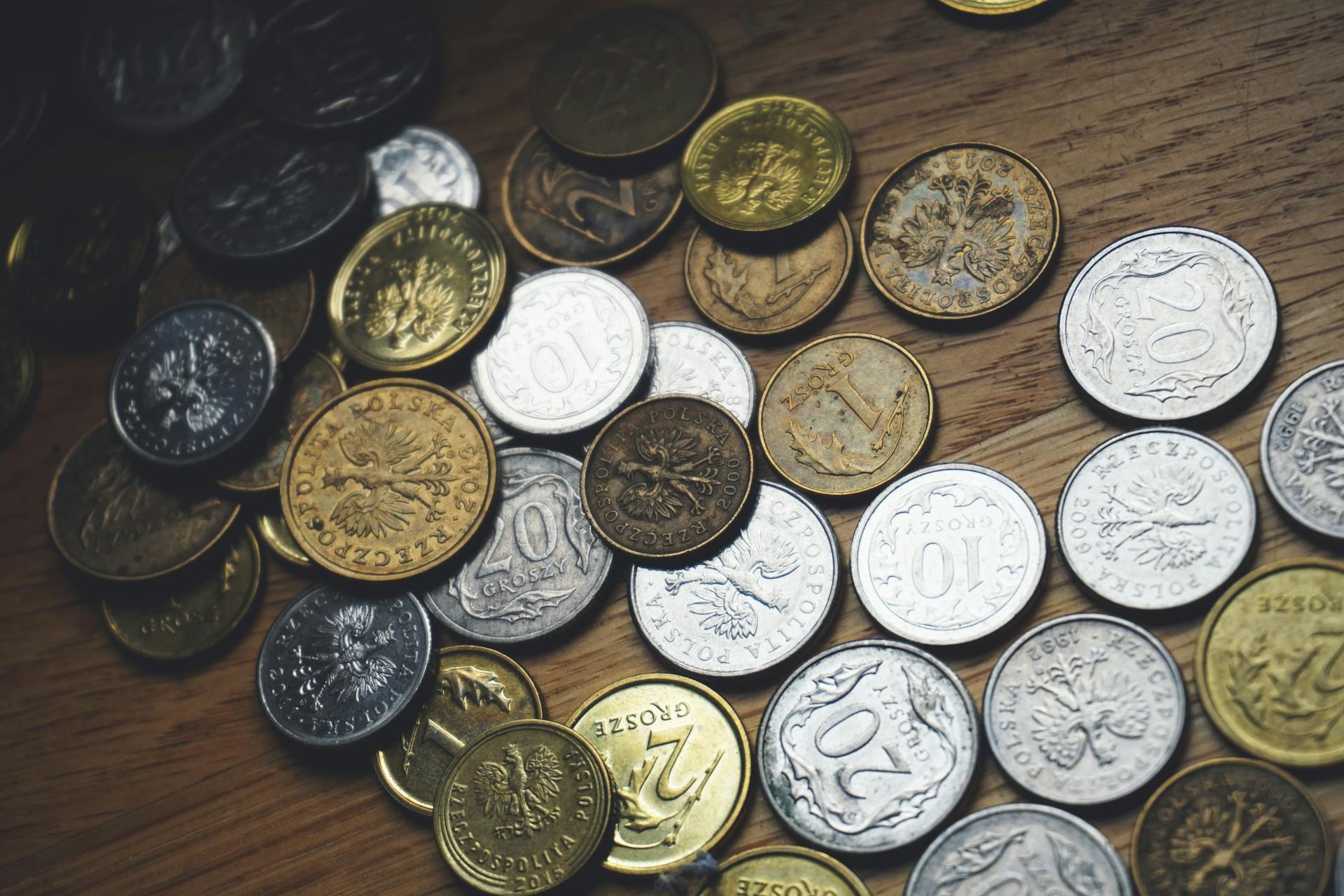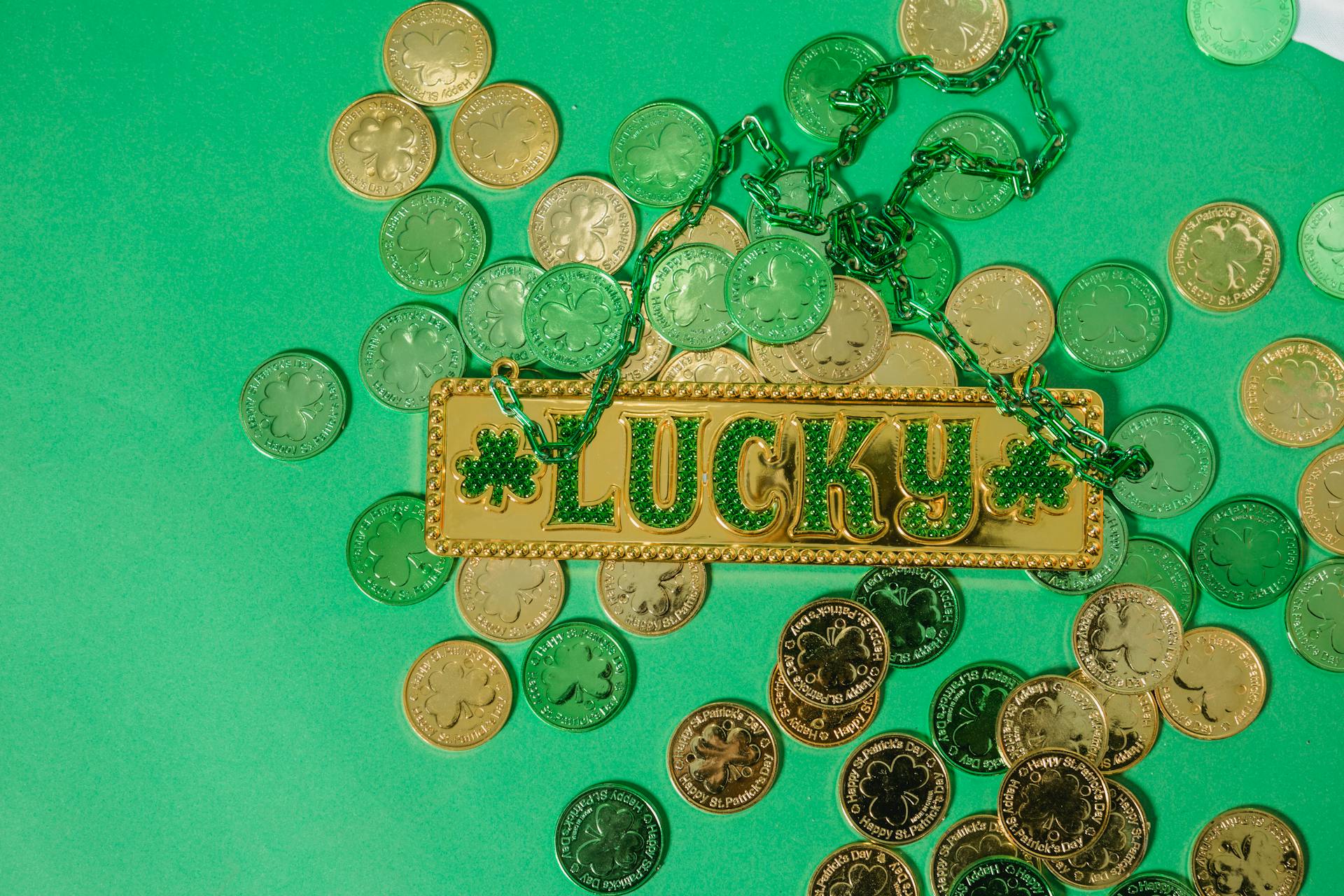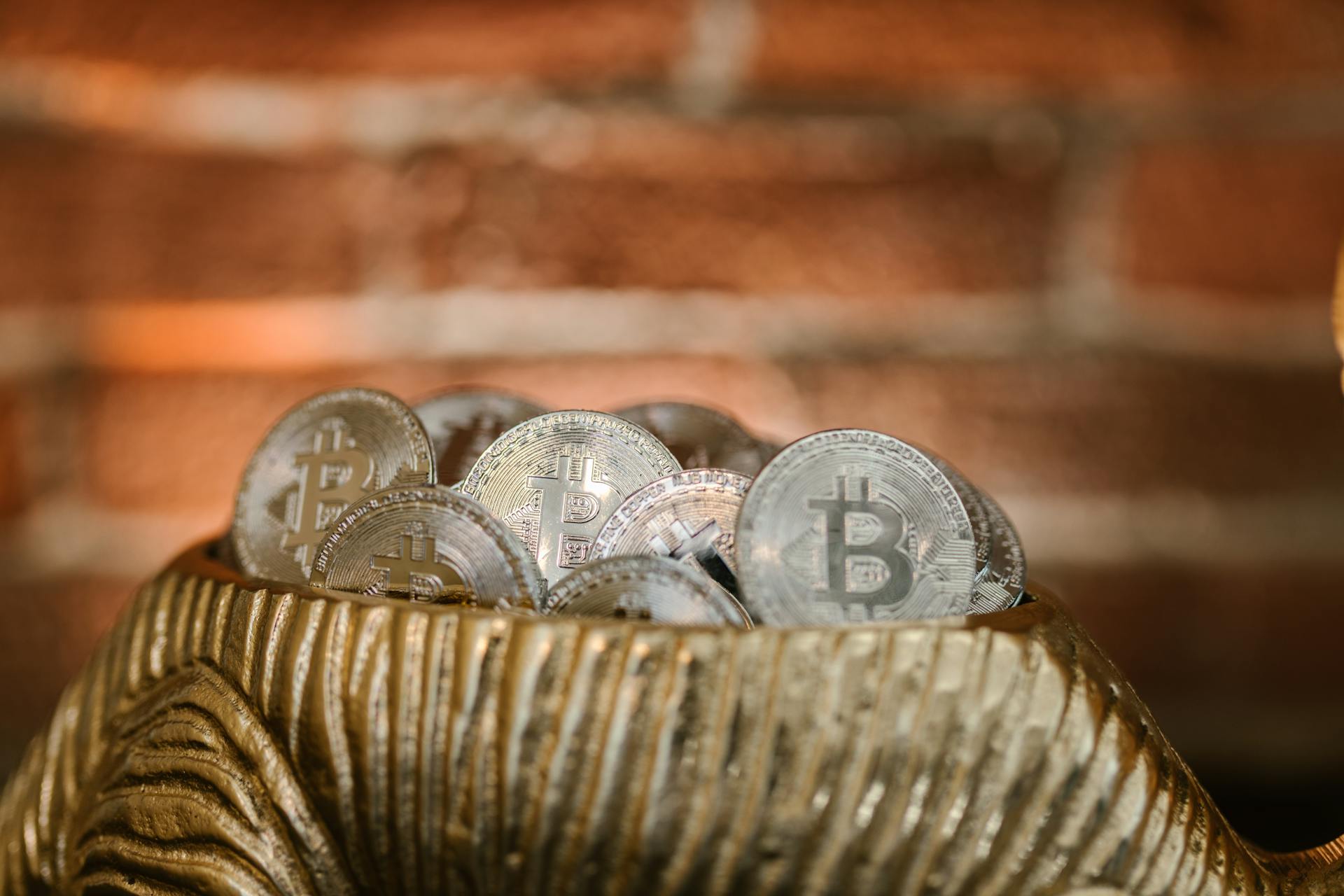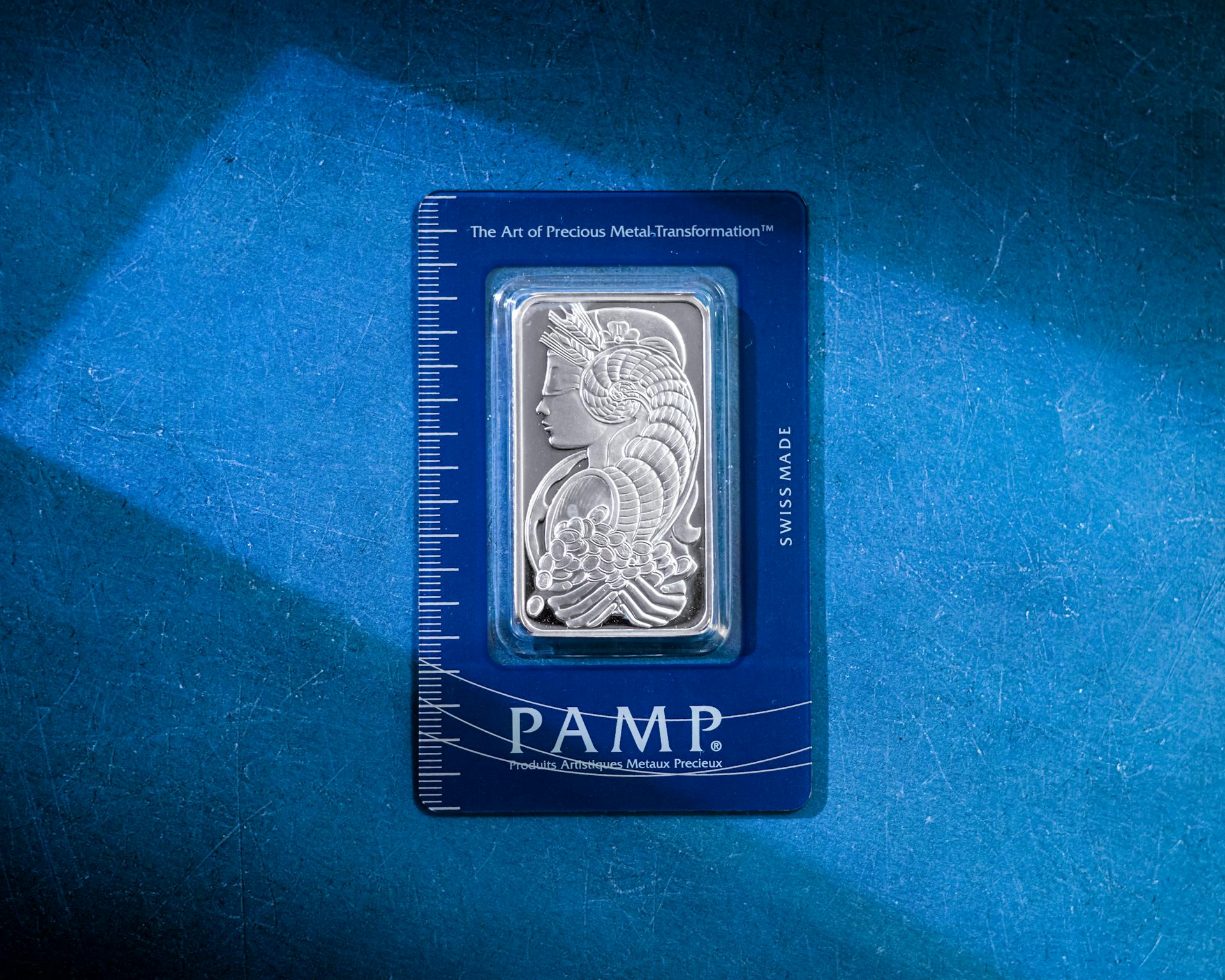
Malaysia has a rich history of coinage, with the first coins introduced in the 13th century during the Melaka Sultanate era.
The first coins were made of copper and featured the image of a lion.
These early coins were used as a form of currency and also served as a symbol of the sultan's power and authority.
The design of the coins was often influenced by the ruling dynasty and the country's cultural heritage.
Coins of Malaysia
Coins of Malaysia can be divided into three stages: Sultanate, Colonial, and Modern. The Sultanate stage includes coins from Sultanate of Johore, Kedah, Tregganu, Kelantan, Pahang, Perak, and Selangor.
The Colonial era consists of coins from Penang, Malacca, Malaya, and British Borneo. These coins were later replaced by the Modern Malaysian coins, which were introduced on June 12th, 1967.
The Modern Malaysian coins were issued by the Bank Negara Malaysia and replaced the British Borneo and Malaya dollar at par value, leading to the introduction of the Malaysian Ringgit. The first series of Malaysian coins were made of cupronickel and featured the federal star and the Malaysian Houses of Parliament.
Here are the denominations of the coins currently used in Malaysia:
Malaysia - 5 Sen
The 5 Sen coin is a denomination that has been in circulation in Malaysia for many years. It was first introduced as part of the Modern Malaysian coins series in 1967, along with coins in denominations of 1, 10, 20, and 50 Sen Malaysia.
Malaysian Ringgit replaced the British Borneo and Malaya dollar at par value in 1967, and the 5 Sen coin was part of this new currency. The first series of Malaysian Ringgit coins were made of cupronickel and contained the federal star found on the national flag of Malaysia.
The 5 Sen coin has undergone design changes over the years. The second series of coins, designed by Low Yee Kheng and released in 1989, featured a different design and was made of an alloy of copper, zinc, and tin. These coins represented the Malaysian culture.
Today, the 5 Sen coin is still in circulation, although most of the earlier series are no longer in use. The current series of coins, minted at the Bank Negara Mint and supplied by the Poogsan Corporation of South Korea, features the same denomination.
Intriguing read: Quasi Universal Intergalactic Denomination
1 Sen

The 1 Sen coin is a staple in Malaysia's currency, with multiple variations minted over the years. The first 1 Sen coin was made of bronze and was introduced in 1967.
The composition of the 1 Sen coin has changed over time, with copper-plated steel being used in some versions. For example, the 1a variant, introduced in 1985, is made of copper-plated steel.
The years in which the 1 Sen coin was minted vary depending on the composition. The bronze version was minted in 1967, 1980, 1981, 1973, 1971, 1968, and 1970, while the copper-plated steel version was minted in 1986, 1985, 1973, 1979, 1980, 1978, 1984, 1988, 1987, 1976, 1977, 1981, 1982, and 1983.
The coin value of the 1 Sen coin also varies depending on the composition. The bronze version is valued between 0.16$ and 0.35$, while the copper-plated steel version is valued between 0.08$ and 1.49$.
Here's a summary of the 1 Sen coin variations:
It's worth noting that the 1 Sen coin is still widely used in Malaysia today, and its variations can be a fun collection for numismatists.
10 Sen
The 10 sen coin is a staple in Malaysia's currency system. It's made of copper-nickel, a durable material that withstands the test of time.
You can find the 10 sen coin with the KM# 5.3, which was minted in various years including 1971, 1973, 1977, 1978, 1979, 1980, 1981, 1983, 1982, 1984, 1985, 1988, 1987, and 1986. The coin value ranges from 0.19$ to 1.50$.
The 10 sen coin is a small but important part of Malaysia's economy.
25th Anniversary of Independence
The 25th Anniversary of Independence was a significant milestone in Malaysia's history, and it's commemorated on a special 1 ringgit coin. This coin was minted in various years, including 1989, 1990, 1991, 1992, 1993, 1994, 1995, 1996, 1997, 1998, 1999, 2000, 2001, 2002, 2003, 2004, 2005, 2006, 2007, 2008, 2009, 2010, and 2011.
The 25th Anniversary of Independence coin is made of copper-nickel, a durable and long-lasting material. This composition ensures that the coin remains in good condition over time.
The value of this coin can vary greatly, ranging from 0.08 dollars to 2.61 dollars, depending on the year and condition of the coin.
10 Ringgit 50th Anniversary
The 10 Ringgit 50th Anniversary coin is a highly sought-after collectible. It's a great example of a rare and valuable coin that's influenced by Malaysia's rich cultural and historical heritage.
This coin was produced to commemorate a significant milestone in Malaysia's history, the 50th anniversary of the Malaysian Volunteer Corps Department-RELA. Its rarity makes it difficult to find and increases its value.
The price of this coin is influenced by its age and condition. Coins in excellent condition and with a rich history are often worth more than those in poor condition or newer issues.
Investors and collectors alike can benefit from investing in rare and unique coins like the 10 Ringgit 50th Anniversary.
Intriguing read: Canada Rare Coins
Monetary History
Malaysia's monetary history is a fascinating topic, and it's essential to understand the evolution of its currency. Prior to the ringgit, Malaysia used the Malay and North Borneo dollar, inherited from the British colonial era.
The introduction of the first series of ringgit coins in 1967 marked a significant milestone in Malaysian numismatics. These coins featured motifs of local flora and fauna, making them a beautiful addition to any collection.
A unique perspective: Rm Ringgit Malaysia
The ringgit has been the official currency of Malaysia since 1967. It's used widely throughout the country and is divided into 100 sen.
If you're interested in collecting Malaysian coins, you'll be pleased to know that there are 291 catalogued coins to choose from. This includes coins from former countries like Malaya, Malaya & British Borneo, and Sarawak.
Here's a breakdown of the different coin-related catalogs you can consult:
- Malaya
- Malaya & British Borneo
- Sarawak
Malaysia issued its first commemorative gold coin in 1993 to celebrate the 25th anniversary of Bank Negara Malaysia. This marked the beginning of a tradition of special mintages that continues to this day.
Malaysia Coin Information
Malaysia has a rich history, and its coinage reflects that. The country's coins are divided into three stages: Sultanate, Colonial, and Modern.
The Sultanate coins include Sultanate of Johore, Kedah, Tregganu, Kelantan, Pahang, Perak, and Selangor. These coins were issued during the Sultanate era of Malaysia.
Malaysia's coins have undergone significant changes over the years. The Colonial era saw the introduction of coins from Penang, Malacca, Malaya, and British Borneo. The Modern era began on June 12th, 1967, with the introduction of the Malaysian Ringgit, which replaced the British Borneo and Malaya dollar at par value.
Recommended read: English Currency History
Here's a brief overview of the Malaysian Ringgit's evolution:
The Malaysian Ringgit is divided into 100 sen, and coins in circulation include denominations of 5, 10, 20, and 50 sen, as well as 1 ringgit.
Current Currency in Circulation
The Malaysian ringgit is divided into 100 sen. Coins in circulation include denominations of 5, 10, 20 and 50 sen, as well as 1 ringgit. The 5 sen coin is a great size for small purchases. Coins of 5, 10, 20 and 50 sen are available. I've used 50 sen coins to buy snacks at a market stall.
Curious to learn more? Check out: 20 Peso Philippines
Malaysia Coin Catalogs
If you're interested in learning more about the coin catalogs related to Malaysia, there's a wealth of information out there.
You can consult other coins related to Malaysia, these catalogs are usually country history: former countries, unifications, independence provinces, colonies, etc.
Malaysia has a rich history, and its coin catalogs reflect this. You can find catalogs that cover the history of Malaya, a former country that existed from 1948 to 1957. This is a great resource for understanding the country's early years.
Malaya & British Borneo is another catalog you can explore. This covers the period from 1958 to 1963, when Malaysia and British Borneo were unified.
Here's a list of some of the notable coin catalogs related to Malaysia:
- Malaya
- Malaya & British Borneo
- Sarawak
Coin Collections
Coin collecting is a popular hobby in Malaysia, with many enthusiasts searching for rare and unique coins to add to their collections.
The first coin collection in Malaysia dates back to the 16th century, with the introduction of the first Malay coins by Sultan Mahmud Shah in 1488.
Malaysian coin collections can be categorized into three main types: ancient coins, colonial coins, and modern coins.
Ancient coins, such as the gold dinar, are highly prized among collectors for their historical significance and rarity.
Colonial coins, introduced during the British colonial era, feature the British monarch's portrait and are highly sought after by collectors.
Modern coins, issued since Malaysia's independence in 1957, feature the country's national emblem and are a great way for collectors to own a piece of Malaysian history.
Some of the most valuable coins in Malaysian collections are those featuring the portrait of Sultan Abdul Jalil Shah, who ruled Malacca from 1571 to 1597.
The rarity and condition of a coin can greatly affect its value, with some coins selling for thousands of dollars at auction.
For collectors, the thrill of the hunt is a big part of the fun, whether it's searching for rare coins in old buildings or attending coin shows to meet other collectors.
Fun Facts
The Malaysian ringgit has an interesting history! The word "ringgit" actually means jagged in Malay, which refers to the serrated edges of the Castilian reales that circulated in the area during the sixteenth and seventeenth centuries.
The ringgit is shared with other countries, but did you know that Malaysia, Singapore, and Brunei used to have an agreement on making their currencies interchangeable? This was until May 8, 1973, when Malaysia decided to leave the economic space.
The ringgit has a unique connection to other currencies in the region. In fact, the Singapore dollar and Brunei dollar are also known as ringgit in Malay. That's why they're often referred to together as the ringgit.
Featured Images: pexels.com


